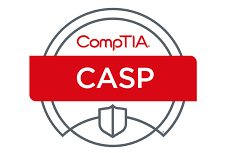-

What You Will Learn
This certification preparation program is designed for IT professionals who want to acquire the technical knowledge and skills needed to conceptualize, engineer, integrate, and implement secure solutions across complex enterprise environments. CASP covers enterprise security, risk management, incident response, research and analysis, integration of computing, communications, and business disciplines as well as technical integration of enterprise components. The target student should aspire to apply critical thinking and judgment across a broad spectrum of security disciplines to propose and implement sustainable security solutions that map to organizational strategies; translate business needs into security requirements; analyze risk impact, and respond to security incidents.
PRICE: $4,290 -
Course Details
Course Duration
12 weeks, 15 hours a week
Credit to be Awarded
CASP Advanced Security Practitioner Certification
Learning method
“Blended”
-
Prequisites
General Requirement
Students must be 18 years of age, and possess a high school diploma, or General Equivalency Diploma (GED), or Home School Diploma.
CompTIA Organization Certification Recommendations/ Prerequisites
CompTIA recommends that students have at least 10 years of experience in IT administration, including at least 5 years of hands-on technical security experience. These are recommendations and are not required in order to be eligible to sit for the CASP certification examination.
CompTIA Organization Certification Exam Requirements
To be certified, students must pass the certification exam on a Pass/Fail only basis, with no scaled score during the allotted 165 minutes for the 80-question exam.
-
Outline
- Managing Risk, and Integrating Computing, Communications, and Business Disciplines
- Using Research and Analysis to Secure the Enterprise, Integrating Advanced Authentication and Authorization Techniques, and Implementing Cryptographic Techniques
- Implementing Security Controls for Hosts, and Implementing Security Controls for Enterprise Storage
- Analyzing and Implementing Network Security, and Implementing Security Controls for Applications
- Integrating Hosts, Storage, Networks, and Applications in a Secure Enterprise Architecture, Conducting Vulnerability Assessments, and Responding to and Recovering from Incidents
-
Module Group 1
Managing Risk, and Integrating Computing, Communications, and Business Disciplines
- Topic A: Identify the Importance of Risk Management
- Topic B: Assess Risk
- Topic C: Mitigate Risk
- Topic D: Integrate Documentation into Risk Management
- Topic E: Facilitate Collaboration Across Business Units
- Topic F: Secure Communications and Collaboration Solutions
- Topic G: Implement Security Activities Throughout the Technology Life Cycle
-
Module Group 2
Using Research and Analysis to Secure the Enterprise, Integrating Advanced Authentication and Authorization Techniques, and Implementing Cryptographic Techniques
- Topic A: Determine Industry Trends and Effects on the Enterprise
- Topic B: Analyze Scenarios to Secure the Enterprise
- Topic C: Implement Authentication and Authorization Technologies
- Topic D: Implement Advanced Identity Management
- Topic E: Describe Cryptographic Concepts
- Topic F: Choose Cryptographic Techniques
- Topic G: Choose Cryptographic Implementations
-
Module Group 3
Implementing Security Controls for Hosts, and Implementing Security Controls for Enterprise Storage
- Topic A: Select Host Hardware and Software
- Topic B: Harden Hosts
- Topic C: Virtualize Servers and Desktops
- Topic D: Implement Cloud-Augmented Security Services
- Topic E: Protect Boot Loaders
- Topic F: Identify Storage Types and Protocols
- Topic G: Implement Secure Storage Controls
-
Module Group 4
Analyzing and Implementing Network Security, and Implementing Security Controls for Applications
- Topic A: Analyze Network Security Components and Devices
- Topic B: Analyze Network-Enabled Devices
- Topic C: Analyze Advanced Network Design
- Topic D: Configure Controls for Network Security
- Topic E: Identify General Application Vulnerabilities
- Topic F: Identify Web Application Vulnerabilities
- Topic G: Implement Application Security Controls
-
Module Group 5
Integrating Hosts, Storage, Networks, and Applications in a Secure Enterprise Architecture, Conducting Vulnerability Assessments, and Responding to and Recovering from Incidents
- Topic A: Implement Security Standards in the Enterprise
- Topic B: Select Technical Deployment Models
- Topic C: Secure the Design of the Enterprise Infrastructure
- Topic D: Secure Enterprise Application Integration Enablers
- Topic E: Select Vulnerability Assessment Methods
- Topic F: Select Vulnerability Assessment Tools
- Topic G: Design Systems to Facilitate Incident Response
- Topic H: Conduct Incident and Emergency Responses

ABL Cyber Range and Academy
an Arizona Licensed School
ABL Cyber Academy - All Rights Reserved ©
